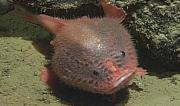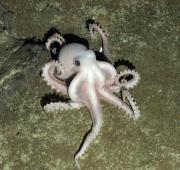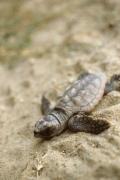Radio Program
Our regular Science and the SeaTM radio program presents marine science topics in an engaging two-minute story format. Our script writers gather ideas for the radio program from the University of Texas Marine Science Institute's researchers and from our very popular college class, Introduction to Oceanography, which we teach to hundreds of non-science majors at The University of Texas at Austin every year. Our radio programs are distributed at to commercial and public radio stations across the country.
A rainy year generally makes for happy trees. They extend not just up, but out, adding a thick layer of new growth. Scientists can pinpoint such years — as well as dry ones, hot ones, and cold ones — in a tree’s rings. That makes the rings great “time machines” for measuring climate over decades or even centuries.
The deep ocean teems with weird and wonderful life, from spiny sea stars to fish that generate their own light.
To many biologists in the 19th century, though, such an abundance of life seemed absurd. With perpetual darkness, cold temperatures, and crushing pressure, it seemed impossible that anything could live very far below the ocean surface.
To John Tuzo Wilson, Hawaii was a puzzle. Wilson was a geophysicist at the University of Toronto in the early 1960s. He was studying plate tectonics – the idea that Earth’s crust is made of a series of thin plates that float atop the mantle.
Most volcanoes are found where the plates intersect. But a few are far from the boundaries of any tectonic plates. That includes the islands of Hawaii, which are in the middle of the Pacific Plate, far from its edges.
The frogfish is a master of deception. It can disguise itself as a rock, a bit of coral, or even a sea urchin as it lies in wait for unsuspecting prey. When a potential meal gets close, it dangles a lure that looks like a wiggling worm or a small shrimp. And at just the right instant, it sucks in the prey faster than the blink of an eye.
Frogfish are found in tropical waters across much of the world. Their stubby bodies can grow to more than a foot in length. And they use the fins on the underside of the body to hop like a frog or even trot across short distances.
The East Scotia Ridge sounds like something straight out of Jules Verne. It’s an isolated realm in the Southern Ocean where hot, chemical-rich water jets from below the ocean floor. Snow-white crabs with hairy bodies and claws pile atop each other in dense beds – a smorgasbord for seven-armed sea stars that are seen nowhere else on Earth. And a new type of octopus, also white, patrols the warm depths.
The phrase “oysters on the half shell” may take on a whole new meaning in the years ahead. The oceans are getting more acidic, making it harder for oysters and other creatures to make their shells. In fact, it’s already happening.
Hurricane Bertha never got close to the United States, but it was a killer nonetheless. The storm meandered around the North Atlantic in July of 2008. It stayed hundreds of miles off the U.S. coast. Even so, it killed three swimmers in New Jersey, and required more than 1500 beach rescues in Maryland – not because of high winds or a massive storm surge, but by creating powerful rip currents.
The smell of bacon sizzling in a frying pan, pizza baking in the oven, or burgers charring on the grill can instantly set the mouth to watering. For young loggerhead turtles, though, it’s the smell of boiling cabbage.
Loggerheads are found all along the Atlantic and Gulf coasts of the United States. They spend almost their entire lives in the water, migrating across thousands of miles. They feed on clams, crabs, mussels, and other shellfish, as well as jellyfish.
Wake Island is a tiny American presence in the eastern Pacific Ocean. Best known as the site of some fierce fighting in World War II, it covers just three square miles. Yet it gives the United States dominion over more than 150,000 square miles of the Pacific – from the fish that swim beneath the surface to the minerals beneath the ocean floor.
Like a big-game hunter in an old jungle movie, the razor clam frequently plops into quicksand. In the clam’s case, though, it’s intentional – the clam makes the quicksand to help it sink into the sandy floor of the shallow waters it inhabits.
The Atlantic razor clam looks quite different from most other clams. In profile, it resembles the handle of an old straight razor – hence its name. It’s found along the Atlantic coast from Canada to South Carolina.






